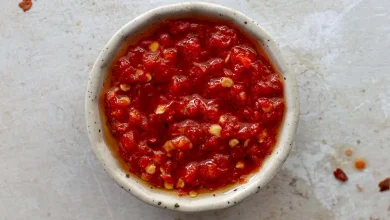🍖🔥👨🍳 Sure, let’s dive into another delicious dry rib recipe! 🍖🔥👨🍳
What is it?
Dry ribs, often referred to as “dry rub ribs,” are a popular barbecue dish. They are a flavorful and mouthwatering way to enjoy ribs without the traditional wet barbecue sauce. Instead of being slathered in sauce, dry ribs are seasoned with a dry rub, which is a mixture of spices and herbs that coat the meat. This allows the natural flavors of the meat to shine through while still providing a tantalizing kick of seasoning.
History:
The concept of dry rub ribs can be traced back to the Southern United States, where barbecue traditions run deep. Barbecue enthusiasts in regions like Memphis, Tennessee, and the Carolinas have long embraced the dry rub technique, valuing the simplicity and purity of flavor it brings to the meat. Over time, dry ribs have become a beloved staple in American barbecue culture and have gained popularity worldwide.
Components:
To make delicious dry ribs, you’ll need the following components:
- Ribs: You can use baby back ribs or spare ribs, whichever you prefer.
- Dry Rub: A flavorful mixture of spices and herbs that can include ingredients like paprika, chili powder, garlic powder, onion powder, brown sugar, salt, black pepper, and cayenne pepper.
- Optional Marinade: Some recipes call for marinating the ribs briefly before applying the dry rub to enhance the flavor further.
- Wood Chips: If you’re using a smoker, you’ll need wood chips (hickory, mesquite, or applewood) for that authentic smoky flavor.
Steps to Prepare:
- Prep the Ribs: Remove the membrane from the back of the ribs for better seasoning absorption. You can do this by sliding a knife under the membrane, then using a paper towel to grip and pull it off.
- Marinate (Optional): If you choose to marinate, coat the ribs with your chosen marinade and refrigerate for a few hours or overnight.
- Prepare the Dry Rub: In a bowl, mix the spices and herbs to create your dry rub.
- Apply the Dry Rub: Generously coat both sides of the ribs with the dry rub mixture. Pat it in to ensure it adheres.
- Preheat the Grill or Smoker: If you’re using a grill, set it up for indirect grilling. For a smoker, follow your smoker’s instructions and aim for a low and slow cooking temperature (around 225-250°F or 107-121°C).
- Smoke or Grill: Place the ribs on the grill grates (or in the smoker) away from direct heat. Add wood chips if you want a smoky flavor. Cover and cook for several hours, maintaining a consistent temperature.
- Check for Doneness: Ribs are done when the meat pulls away from the bone easily and has a nice bark (outer crust). This can take anywhere from 3 to 6 hours, depending on the temperature and thickness of the ribs.
- Rest and Slice: Allow the ribs to rest for about 10 minutes before slicing them into individual ribs or portions.
- Serve: Plate your delicious dry rub ribs and enjoy!
Time Needed:
The total time required to prepare dry ribs can vary based on factors like the type of ribs, cooking equipment, and your desired level of tenderness. On average, it takes approximately 3 to 6 hours for the ribs to cook to perfection. Marinating time, if you choose to do so, can add a few extra hours. So, plan ahead for a mouthwatering feast!
Enjoy your finger-licking good dry ribs adventure! 🍖🔥😋
Certainly! Here are some nutrition facts and health information related to dry ribs:
Nutrition Facts (per 3-ounce serving of cooked ribs):
- Calories: Approximately 230-250 calories
- Protein: About 20-25 grams
- Total Fat: Around 15-20 grams
- Saturated Fat: Approximately 5-8 grams
- Carbohydrates: Negligible (Ribs are low in carbs)
- Fiber: 0 grams
- Sugars: 0 grams
- Sodium: Varies depending on the dry rub and seasoning used, but it can be high, so it’s essential to moderate your salt intake from other sources.
Health Information:
-
Protein Source: Dry ribs are a good source of high-quality protein, which is essential for muscle maintenance and repair.
-
Fat Content: Ribs can be relatively high in fat, with a significant portion being saturated fat. While fat adds flavor, it’s advisable to consume them in moderation, especially if you’re watching your saturated fat intake.
-
Calorie Consideration: The calorie content can vary based on factors like the cut of the ribs and the dry rub’s ingredients. If you’re calorie-conscious, be mindful of portion sizes.
-
Sodium Concerns: Dry rubs can contain salt and other seasonings, contributing to sodium content. High sodium intake can affect blood pressure, so individuals with hypertension should consume ribs in moderation.
-
Balanced Diet: Enjoying dry ribs as an occasional treat within a balanced diet that includes plenty of fruits, vegetables, and whole grains can help you maintain a healthy eating pattern.
-
Cooking Methods: The health impact can also be influenced by the cooking method. Grilling or smoking the ribs can be a healthier choice compared to deep-frying, as it reduces the amount of added fats.
-
Customization: You can make dry ribs healthier by choosing leaner cuts of meat, using a leaner dry rub recipe, and watching the portion size.
Remember that while dry ribs can be a tasty indulgence, they are best enjoyed in moderation as part of a well-rounded diet to maintain overall health. It’s also a good idea to consult with a healthcare professional or nutritionist for personalized dietary recommendations.



